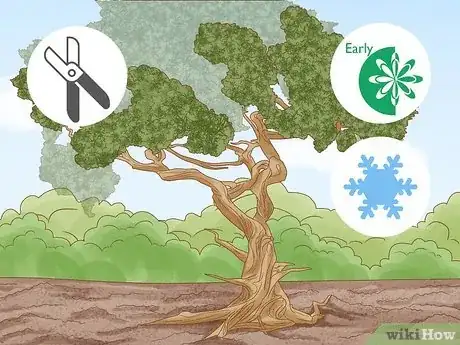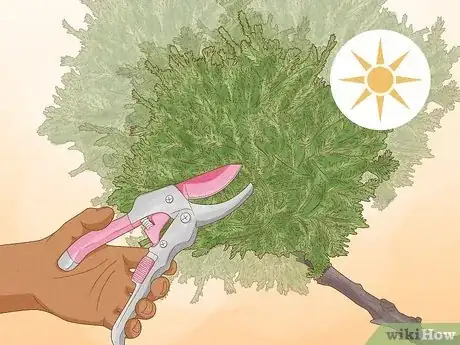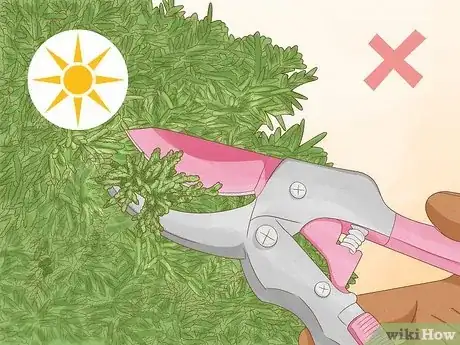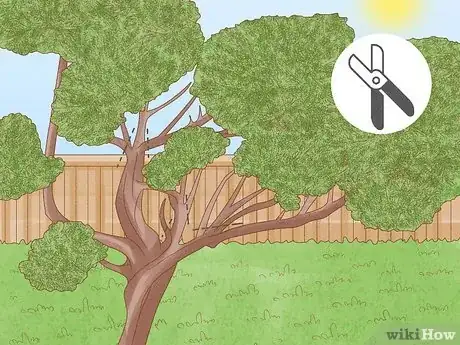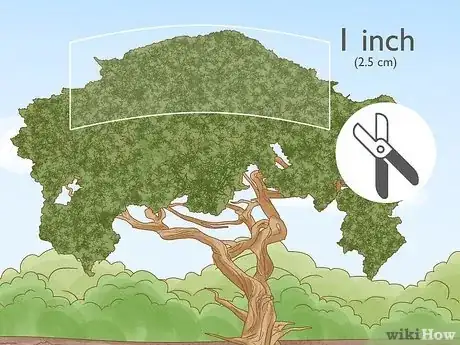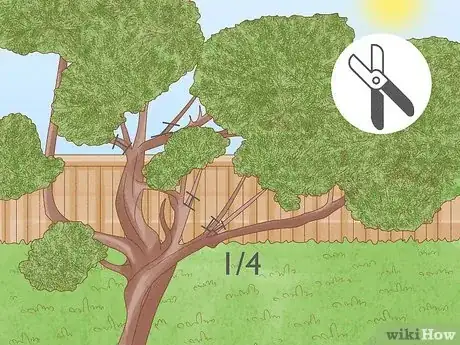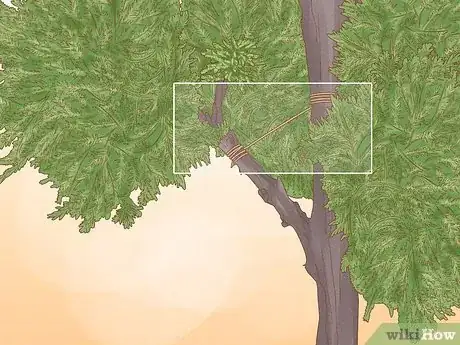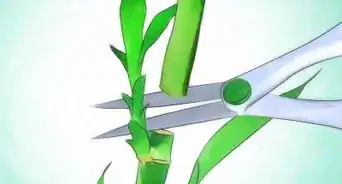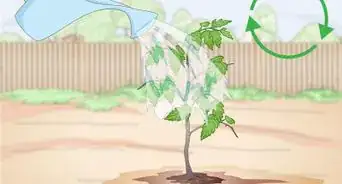This article was co-authored by Lauren Kurtz. Lauren Kurtz is a Naturalist and Horticultural Specialist. Lauren has worked for Aurora, Colorado managing the Water-Wise Garden at Aurora Municipal Center for the Water Conservation Department. She earned a BA in Environmental and Sustainability Studies from Western Michigan University in 2014.
This article has been viewed 76,099 times.
Junipers trees are a type of hardy evergreen that can grow almost anywhere in the world. There are many different species, but they all have certain characteristics in common, including a narrow shape, fragrant blue fruits, and unique branch texture. You can easily prune your juniper tree to control its shape and encourage new growth!
Steps
Pruning at the Right Time
-
1Prune junipers annually to correct their shape. The best time to prune your junipers is in the winter or early spring. In the springtime, it’s easier to see the general shape of the tree and cut the branches without having to worry about accidentally harming new growth.[1]
- Winter pruning is a great option because it ensures that the plant is pruned before new growth begins.
- It’s important to work before new growth begins so that you don’t have to worry about damaging new branches. This will give you the freedom to trim as needed to attain the perfect shape.
-
2Trim the bushes as needed in the summer if the tree loses its shape. After you’ve corrected the shape of the bush in the spring, you may notice that the juniper grows faster and wider during the summer. You can re-shape the tree at any time during the summer.[2]
- Junipers can be trimmed any time from spring until the first freeze of the year.
Advertisement -
3Do not trim new growth during the summer. When working with the tree, be careful not to cut the new growth growing from the junctions. The new growth will be soft, light green, and pliable compared to the hardwood of the old growth. Always be gentle when touching new growth, as it’s extremely delicate.[3]
- If you are working during the springtime, there likely won’t be much new growth to avoid.
Trimming the Juniper
-
1Avoid pruning healthy branches into the “dead zone” at the center. The center of the shrub doesn’t get much light, so most of the greenery in this area dies to conserve energy for the outer portion of the shrub. On a mature juniper, nothing will grow from this area, so you have to be careful not to cut too close unless you do not want the branches to grow back.[4]
- It’s easier to see the dead zone in the early spring when there isn’t much new growth.
- Sometimes, if the juniper is very mature, the dead zone will be extremely large. If the dead zone makes up the majority of the plant, dig up the juniper and replant a new shrub in its place.
-
2Make cuts at the junctions of the branches. In all varieties of junipers, new growth comes from points in the tree where the branches split into 2-3 smaller branches, called junctions. When pruning the tree, try to make cuts as close to the junctions as possible to encourage more new growth throughout the year.[5]
- After you trim the branches to the junctions, keep an eye out for new growth.
-
3Cut out dead or damaged limbs using loppers to encourage new growth. You may notice that some of the branches of the tree are brown and stiff. Take a pair of loppers, which are a type of gardening scissor with long handles, and cut all dead or damaged limbs into the dead zone. This will give new growth space to form![6]
- In this case, it’s okay to cut into the dead zone because the branches are already dead, and there will be more space for new growth to expand on the outer area of the bush.
-
4Thin out creeping junipers by removing center branches. Creeping and semi-upright junipers can have very thick dead zones that need to be thinned out. Use a pair of pruners or loppers to cut 30% of the central limbs out of the tree, opting for the most mature branches. Cut these branches into the dead zone to prevent them from growing back.[7]
- Doing this helps to prevent disease in the bush and allows more light to reach the buds at junctions toward the center of the tree.
- After the initial thinning, creeping and semi-upright junipers can be pruned as normal.
-
5Trim top branches using loppers to shape the tree. Many junipers grow laterally, with branches shooting off to the sides, but some may have branches growing upwards. Use the loppers to cut the branches to about 1 inch (2.5 cm) outside of the dead zone to encourage more upward growth.[8]
- If you can’t find a junction, simply cut the branch to match the overall shape and height of the bush.
-
6Prune side branches by 1/4 of their length if they stick out from the bush. The side branches take up the most space on an overgrown juniper. Use pruning scissors or hand pruners, which have shorter handles than loppers, to shorten the branches to a junction where the branch splits. You can cut up to a third of the branch without damaging its growth.[9]
- For example, if the length of a protruding branch is 24 inches (61 cm), you should prune 6 to 8 inches (15 to 20 cm) off of the branch.
-
7Tie sagging branches to the center of the shrub to secure them. Even after pruning the side branches by a quarter or third, they can still sag and stick out from the tree. Use twine or tree ties to secure the branches to the center of the tree. Tie the twine around the branch and then secure it to the middle of the shrub.[10]
- Do not use wire to do this unless you are also using tree straps around the branches. Wire will rub against them.
- Tree ties tend to be sturdier than twine, but they’re more expensive. You can find them at most home improvement stores or garden centers.
- After a year, you will need to remove the ties, and the branches should remain in place without the ties.
Community Q&A
-
QuestionHow deep is an upright juniper root?
 NinoxTop AnswererIt depends on the age of the tree, but varies between 0.5 and 7.6 m (1.6 and 25 ft).
NinoxTop AnswererIt depends on the age of the tree, but varies between 0.5 and 7.6 m (1.6 and 25 ft). -
QuestionIf a juniper gets pruned too far on the top, will it come back?
 NinoxTop AnswererJuniper trees do not support top cutting. It will survive, but it will be weakened.
NinoxTop AnswererJuniper trees do not support top cutting. It will survive, but it will be weakened.
Warnings
- Always wear gloves when using pruning equipment to protect your hands from cuts and scrapes.⧼thumbs_response⧽
- Never use shears to shape the tree as they can damage the branches and stop growth.⧼thumbs_response⧽
Things You’ll Need
- Loppers
- Pruners
- Twine or tree ties
References
- ↑ http://www.mortonarb.org/trees-plants/tree-and-plant-advice/horticulture-care/pruning-evergreens
- ↑ http://www.mortonarb.org/trees-plants/tree-and-plant-advice/horticulture-care/pruning-evergreens
- ↑ http://www.landscapeadvisor.com/how-to-prune-upright-junipers/
- ↑ https://hortnews.extension.iastate.edu/2003/3-7-2003/pruneshrub.html
- ↑ http://www.mortonarb.org/trees-plants/tree-and-plant-advice/horticulture-care/pruning-evergreens
- ↑ http://www.landscapeadvisor.com/how-to-prune-upright-junipers/
- ↑ http://www.landscapeadvisor.com/how-to-prune-upright-junipers/
- ↑ http://www.finegardening.com/article/pruning-arborvitae-junipers-and-chamaecyparis
- ↑ http://www.finegardening.com/article/pruning-arborvitae-junipers-and-chamaecyparis
About This Article
Start pruning your juniper tree by removing dead limbs and branches with loppers. Once all of the visibly dead branches have been cut, shape the tree by pruning protruding branches at the top of the tree and on the sides. Cut the protruding branches to a junction where the branch splits into 2 branches to encourage new growth. Be careful not to trim the branches too close to the center of the tree! For more tips on how to prune your juniper, including how to thin creeping and semi-upright junipers, keep reading!
